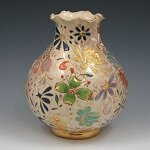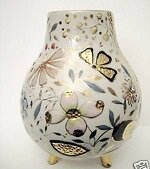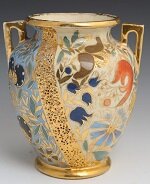
The Cincinnati Art Pottery Company
William Dell Hungarian Faience
The Cincinnati Art Pottery Co. opened in Cincinnati, Ohio in 1879. Noted artist Thomas J. Wheatley worked there until 1882. Their first line was under-glaze decorated pottery, but that was quickly discontinued. Their "Barbotine ware" followed, which was an applied pottery style, and was also short-lived. The Hungarian Faience was by far the most popular, with bright multi-colored applied glazes over a white clay. Later came the "Portland Blue Faience", described as a dark blue glazed ware with gold decorations. Their final product was "Kezonta ware", described as ivory colored faience with natural floral colors and gold scroll-work. The pottery was closed in 1891, but artist William Dell continued to produce pieces from the original molds for a few years before closing forever.
Typical marks found on Hungarian Faience are the WM DeLL & CO ink-stamps. There were several others, including CAP marks which are usually incised. Sometimes they are unmarked except for the shape numbers, and often the shape numbers are die-impressed and at other times they are inscribed by hand.
Below is a selection of Hungarian Faience shapes for reference. It is worth noting that no two pieces have been discovered with identical designs even if the shape is the same. Each work may be unique. It is not known if molds were shared with other lines. Shape no.10 was made both as an ewer and as a shorter egg vase without spout or handle applied.
-

William Dell Ink-Stamp
-

Shape #2
-

Shape #3
-

Shape #6
-

Shape #7
-

Shape #9
-

Shape #10
-

Shape #25
-

Shape #27
-

Shape #28
-

Shape #29
-

Shape #32
-

Unknown Shape Number
We highly recommend these books for collectors of William Dell and Cincinnati Art Pottery. They provide vast amounts of information about the most popular America Art Pottery companies. This website may receive compensation for qualified purchases of these books.




